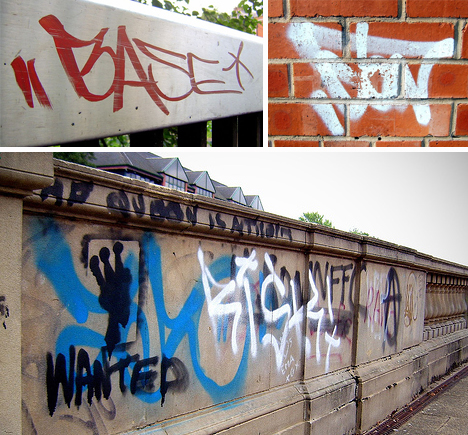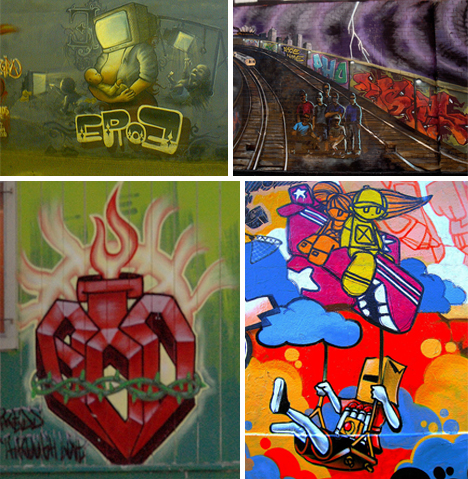http://www.youtube.com/watch?v=WzWkg-cVhgA
This video is to show you the Styles and techniques of how to write graffiti style
Graffiti History
Wednesday, January 11, 2012
Friday, November 25, 2011
Graffiti Styles
Graffiti has a lot of Styles you can make.This Styles depend on you what you choose. These Styles has a lot of alphabetic letters which makes it more artistic.Graffiti Styles are used to make the wall more creative and more artistic when it comes to styling your graffiti words. These are the example of Graffiti Styles/Design.







Tag

(images via: orangeacid)
Tagging is the simplest type of graffiti, consisting of the writer’s street name in one color. Tags are basically the graffiti writer’s signature; if they’re associated with a crew, they might also contain the crew’s name or initials. Tags can be seen everywhere and are done in spray paint, markers or pens. If a tag is put up over another writer’s tag or piece, it’s extremely disrespectful.
Throw-Up

(images via: kami68k)
A throw-up is a little more complicated than a tag, usually having two or three colors, but not nearly as elaborate as a piece. A throw-up is something that can be done quickly and repeatedly, while still identifying the writer. They’re usually done in bubble letters, often in one color with a differently-colored outline. When a graffiti writer goes out bombing, they’re usually either putting up tags or throw-ups all over their area.
Stencil

(images via: urbanartcore.eu)
Using stencils is a quick and effective way to put up somewhat-complicated pieces very quickly. By holding the stencil against the wall and spraying, you can get a much more detailed picture than you would be able to with just a spray can. Even if you use two or three layers to make a more colorful and intricate picture, stencil graffiti can be thrown up in a matter of minutes. This is the type of graffiti that was made popular by the likes of Blek le Rat and Banksy and has now taken hold with graffiti writers everywhere.
Stickers (Slaps)
(images via: djwudi)
Stickers are a quick and easy (some say lazy) way to throw up a tag quickly. Graffiti writers used to use the “Hi, My Name Is” name tag stickers, but these days it’s also common to see them on the free address labels you can get from the Post Office. It’s just as likely to see elaborate, professional-looking printed stickers with a message or image plastered all over. Graffiti artists like stickers because they can take their time on the art in private, then quickly slap them up wherever.
Wildstyle

(images via: ferretfacejones)
Wildstyle is a particular style of writing that was developed and popularized by graffiti artists like Tracy 168, Stay High 149 and Zephyr in New York City. It’s a complicated and extremely stylized form of writing that, to the untrained eye, is not easy to read. Wildstyle writing features arrows, spikes, curves and other elements that non-graffiti artists may have a hard time understanding. Wildstyle pieces are often 3D and considered to be one of the most complicated forms of graffiti.
Piece

(images via: fooishbar, ash-man, Marshall Astor & Caneles)
A piece (short for masterpiece) is a graffiti painting, much more complex than a tag and having at least three colors. Pieces are hard to do illegally because of the time and effort involved, so a good piece will gain a lot of respect for that particular graffiti artist. As graffiti has gotten more respect as a legitimate art form, a lot of pieces have been commissioned – or at least the artists given permission to put them up.
Blockbuster

(images via: otherthings, meophamman & RepoMan84)
A blockbuster is used to cover maximum area in a minimal amount of time. Often consisting of large block letters, the blockbuster can be accomplished with paint rollers and two or three colors of paint. Usually a blockbuster is put up to cover up other work or block other writers from putting anything up on the same area.
Heaven

(images via: two instincts & Liam d’Noit)
A heaven is a piece that’s put up in a very hard-to-reach location, often near or on the tops of tall buildings or on freeway signs. Because they’re so dangerous and difficult to reach, graffiti artists who manage to get a piece up in such a spot will usually gain some added respect from their peers.
Thursday, November 24, 2011
Graffiti Requirements
If you want to use or to draw Graffiti you need to follow these requirement:
The Graffiti Gard is a nanotechnological, permanent and non-stick coating. The Graffiti Gard
incorporates a unique nano-polymer with an extremely highly slip coefficient that both penetrates the
structure and builds a durable non-stick film. It is single component, water-clear, UV stable, heat stable
and has extreme chemical resistance. This product forms both a mechanical and chemical bond to
inorganic and organic substrates making it universal in its application. The Graffiti Gard does not allow
paint, graffiti, permanent marker, stickers and other markings to bond to the dry film. This product has
been tested in a wide variety of climates and shows no deterioration from ultraviolet rays, ozone, salt
spray or acid rain. The Graffiti Gard allows for expansion and contraction, building movement,
temperature extremes and thermal cycling. This product is non-toxic, environmentally friendly, nonreactive,
VOC, AQMD and CARB compliant.
Graffiti Gard exceeded the performance requirements for ASTM D6578 Graffiti Resistance
Test. This product is packaged in 20 oz. aerosol cans with a net wt. of 12 oz.
PRODUCT DESCRIPTION
•Non-sacrificial, non-yellowing and clear •Non-stick characteristics •Single component •Allows
expansion and contraction •Can be applied to horizontal, vertical and wear surfaces •ASTM D6578
APPLICATION GUIDELINES
Surface Preparation:
The surface is to be clean and free of any foreign matter. Apply the Graffiti Gard to any surface or
substrate. Some porous substrates may require more than one coat. The product may be applied at 40
degrees F and above and as long as there is no frozen moisture in the substrate. Product must be applied
to a dry surface. Always apply to a test area before proceeding with entire application.
Graffiti Gard will darken porous surfaces. Test in an inconspicuous area before application. Coated
surfaces may be washed with water or mild detergent.
Application:
1 Shake the product well before application.
2 Apply your first application as a flood coat and apply liberally.
3 Allow the first coat of the Graffiti Gard to cure approximately 4 hours in ambient conditions.
A single coat may be sufficient but a second or third coat can be applied depending on your
application, substrate or requirements.
*PURGE NOZZLE AFTER USE: HOLD CAN UPSIDE DOWN AND SPRAY TO
FLUSH NOZZLE AND PREVENT CLOGGING
.Graffiti Removal:
•Remove graffiti as soon as possible after surface has been vandalized.
•Success has been achieved by using: -A dry paper towel or dry soft light abrasive material.
•Water and detergent at no more than 10% -The Syndyx Clean N’ Easy Graffiti Gone Wipes
•Pressure washing under 1000psi - Pressure over 1000 psi may threaten the integrity of the coating.
•Any light alkaline, citrus, acetone cleaner. Make sure to flush the coating with water after chemical
cleaning to ensure the integrity of the coating. Always test chemical cleaners before moving into a full
application.
COVERAGE
One can of Graffiti Gard will cover approximately 30 square feet depending on the substrate.
LIMITATIONS
Product application must not be initiated during inclement weather or when precipitation appears to be
imminent. Product must not be applied to wet, frozen or dirty surfaces. Product must be checked and
reapplied as needed in the specific area that has undergone sandblasting or soda blasting. Always apply
test area before proceeding with entire application.
*If the coating has been damaged or removed simply make sure the surface is clean and dry and
reapply.
~if you followed this requirements you can use graffiti ang learned how to use graffiti by following these requirements and this requirements need to be learned rather using it immediately.
COMPOSITION & MATERIALS
Friday, October 21, 2011
About Graffiti

The term graffiti referred to the inscriptions, figure drawings, etc., found on the walls of ancient sepulchers or ruins, as in the Catacombs of Rome or at Pompeii. Usage of the word has evolved to include any graphics applied to surfaces in a manner that constitutes vandalism.
Graffiti is an art that symbloize your actions, related and means for your life!...
Subscribe to:
Posts (Atom)
